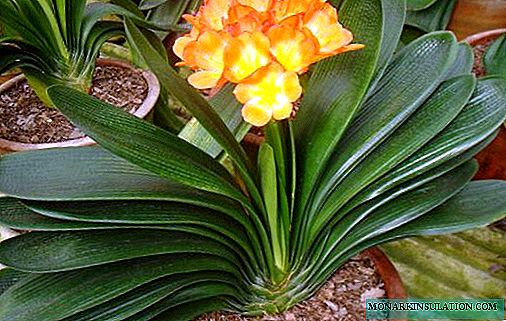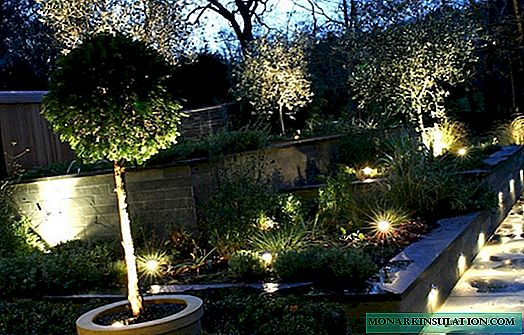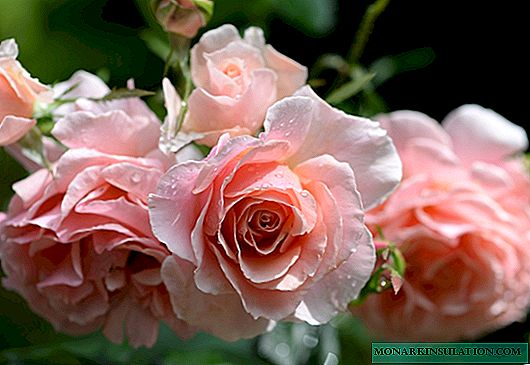
The acquisition of a land plot for the construction of a country house is a joyful event. Surely its owner has many plans and wants to immediately begin to implement them. But where to start? You need to start with the layout of the site. After all, you need to know exactly where the house will be located, outbuildings and other facilities whose construction is planned. Most likely, the plot will have a garden, flower beds and, possibly, a pond or pool. In order to place all this correctly, effectively using the entire available territory, you need to know how to plan a site for a country house.
Why do I need a site plan?
A well-designed plan is necessary for any site, regardless of its size and shape. If this is not done, then during the construction and breakdown of the garden and flower beds, it may turn out that the objects are located irrationally: there are hard-to-reach "pockets" that will have to be empty in the future. If you manage to redo something without significant costs, then when transferring capital buildings you will have to make significant financial and labor costs.

A plan is necessary for the arrangement of each plot, regardless of its size: only in this case each of its objects will be in its place
The presence of a site organization plan will allow you to consider in advance the location of capital construction and temporary buildings, the location of fruit trees and shrubs, flower beds, and so on. The scheme, drawn up taking into account the wishes of all family members, will help to calculate in advance the amount of funds that will be needed for its implementation. In addition, a carefully planned territory allows you to look a little into the future. For example, provide a playground or a place for a car.
Proper site planning allows you to save on costs associated with energy and water supply, with sanitation, heating and irrigation of the site. Residential buildings will be oriented so that they have natural light, but it is not hot from the scorching summer heat. The playground will certainly be visible from the kitchen window so that the children can be supervised, even if mom prepares dinner.

When drawing up the plan, special attention should be paid to the playground. It should always be in the field of vision of adults, be sufficiently obscured and lit.
However, some rules for the location of objects on the site are strictly regulated and do not depend on the desire of the owner. They simply need to be known so that no further misunderstandings arise, and follow them strictly. Some nuances of this issue will be highlighted in the video, which is located at the very end of this article.
How to improve the cottage plot, read here: //diz-cafe.com/plan/kak-oblagorodit-sadovyj-uchastok.html
Basic provisions when planning the site
When drawing up a plan for a suburban area, many different factors must be taken into account. For example, the form of the allotment, buildings that are located near it, as well as the characteristics of the terrain, can have a significant impact. In particular, the location of your land is very important.

Not all sites have a traditional rectangular shape. There are, for example, triangular. But proper planning can turn this flaw into a virtue
Be sure to take into account whether the land is on a hill or in a lowland, whether there is any reservoir near it. It would be nice to know what was possible on this place before, once there was a forest growing here or it is just a piece of the steppe plain. Given these important circumstances, even on a small plot of land you can put all the planned objects.
The following factors deserve special attention:
- The terrain. The location of utilities, the location of the main house and the necessary outbuildings may depend on how smooth the plot you got, what the surrounding landscape is.
- Soil type. Soils in Russia can be different. There are lungs and fertile, on which you can grow different plants. Sandy or heavy clayey, as well as loam may come across. If the soil is “poor”, it will have to be carefully maintained, and in some cases, special fertile soil will have to be brought to the site.
- The shape of the plot. Not all areas are rectangular, although this shape is considered traditional. Allotments can even be triangular or in the shape of the letter "G".
- Reservoirs. It is important to consider not only the proximity of surface water bodies, but also the presence of groundwater, their level. If there is groundwater and are close to the surface of the earth, you will have to install a drainage system.
- Plot position on the horizon.
Feature # 1 - Landform
The place under the garden should be chosen taking into account the relief of the surface of the earth. It depends in which direction the water will flow after rain or snow melting. Take into account the possible impact on the landing of spring flood.

The complex relief of the site is sometimes not amenable to adjustment, but the negative consequences arising from changes in surface levels can and should be prevented
Using the information received about your land allotment, you can timely prevent some negative consequences. For example, to level the surface, you can somewhere remove the soil, and somewhere, on the contrary, add soil. In advance, you can take care of the gutters or blind areas of buildings.
The slopes can be strengthened by constructing terraces, stairs, special slopes or retaining walls. Sometimes, in order to grow plants on a site with an uneven surface, it is necessary to use a vertical layout.
You can learn more about how to strengthen the slopes and slopes on the site from the material: //diz-cafe.com/plan/ukreplenie-sklonov-na-uchastke.html
Feature # 2 - location based on cardinal points
It is very important to consider how the site is located relative to the cardinal points. After all, the correct placement of buildings depends on this, allowing you to use the features of the lighting put on during the daylight hours. For example, if large trees and buildings are located on the northern side of the site, then the shadow falling from them will not adversely affect other green spaces.

Most of the windows of the house should be facing south or southeast, which allows maximum use of natural daylight in all rooms
In this case, the house should be oriented by the facade in a southerly direction. Then in his rooms it will be light from dawn to dusk.
Feature # 3 - Consideration of Reasonable Traditions
Do not neglect reasonable traditions: leave between the facade of your house and the street a small piece of land under the front garden. This piece of land, filled with flowers and green plants, will perform not only a decorative function. It will protect the house from dust and street noise.
The front garden is a place where you can implement the most daring design decisions, read about it: //diz-cafe.com/ozelenenie/palisadnik-pered-domom-svoimi-rukami.html

The presence of a front garden is not only beautiful, but also reasonable, since green spaces are a natural barrier to noise and dust that penetrate from the outside
Division of a suburban area into zones
We will think globally so that at this stage we don’t get stuck on the details. To do this, we divide the entire area into zones in accordance with their functional purpose.

The division of the entire territory of the site into zones - zoning - is fundamental, the details of the plan will be worked out at the next stage
So, we have to highlight:
- Residential area. Here the most important building will be located - the house, as well as all additional buildings that are attached to it. It can be a garage, terrace, summer kitchen, etc.
- Rest zone. It’s better to relax away from farm buildings. We need to choose a place near the house, but at the end of the site, which is hidden from the eyes of strangers.
- The area of the garden. For this purpose, you need to choose a well-lit place, convenient for watering. Here it will be possible to compactly place shrubs, fruit trees and beds.
- The economic zone. This is a work area. It should be located in the opposite end of the site from the rest area. Here are concentrated buildings for household purposes, premises for keeping animals and birds (chicken coop, rabbitry, etc.).
The largest of all can be considered the zone of the garden. It occupies about half or even most of the entire area. As a rule, approximately 1/10 of the entire territory is allocated for housing. A little more space is occupied by buildings for household purposes. If the remaining space seems insufficient for the arrangement of the recreation area, you can increase this area at the expense of the garden, kitchen garden or economic zone.
When the principle zoning is done, you can draw the details of the plan.
Examples of planning land plots for 6-20 acres will also be useful: //diz-cafe.com/plan/primery-planirovok-uchastkov.html
Detail work plan
Let's say your dreams are ahead of financial opportunities. This is a common situation, but you should not be discouraged. Put on the plan everything that should appear on your site over time, regardless of whether you are ready for these expenses today or not.
The time will come when new expenses will become your shoulder, then it will be possible to realize what is planned in full. It is important to include everything in the plan, and then strictly follow it. If you constantly change decisions, over time you can make sure that chaos has formed on the site.
The process of developing and detailing the plan will greatly facilitate the free online garden plot designer: //diz-cafe.com/planirovshhik.html

At the stage of detail, not only specific objects appear on the site plan, but their parameters, made on a scale, also begin to appear
Having calculated the parameters of future buildings, it is necessary, using scale, to draw their contours on graph paper. The more detailed the plan, the more accurate its implementation will be, and the less mistakes will be made in the process of its implementation.
In addition to buildings, it is necessary to draw all the elements of other zones. For example, to mark fences, paths, to break future beds and flower beds. At the same time, try to make the tracks comfortable. It is not necessary that they be straight. Smooth bends give them a more natural look. At the same time, your site will get rid of the banality. In addition, all the proposed sites must be applied to the plan, and at the same time, the tracks must receive not only the direction, but also the width.

Do not try to make the paths on your site perfectly straight, you yourself will be uncomfortable to use them, and you will round the corners and spoil the lawns
Now you can allocate a place for trees and shrubs. Let on the plan they will have the form of circles of the corresponding size. To determine the types of plantings, take a guide and select those plants that correspond to the area of your residence. This will help to approximately estimate the upcoming primary expenses for landscaping the site.
It will also be useful to review the best varieties of ornamental shrubs for arranging a garden: //diz-cafe.com/ozelenenie/dekorativnye-kustarniki-dlya-sada.html
The largest trees should be located in a part of the site remote from the house. The recreation area can be surrounded by decorative deciduous shrubs that bloom beautifully. Dwarf conifers or berry bushes, for example, hawthorn, can be planted along the paths. From the supposed direction of the winds, plants with large leaves and a dense crown are planted.

Despite the fact that the garden area is allocated the largest area, it is not worth abusing tree planting: they need a place for growth and development
For flower beds we are looking for the most sunlit places. Pay attention to the entrance area, relaxation area and the space in close proximity to the house. If this site already had owners, it is better to leave the beds for vegetables and berries in those places where they already were. The reason is simple: the land in this place is already fairly deified and it will only be enough to fertilize it in a timely manner. If you got virgin soil, make beds between the recreation area and the outbuildings.
Garden arbor with barbecue. Overview of 2 examples of DIY construction: //diz-cafe.com/postroiki/besedka-s-mangalom-svoimi-rukami.html

Like flower beds, beds also do not have to have a regular rectangular shape. As you can see, the round bed for greens, broken into sectors, is convenient and original.
Next, it is necessary to determine the places for vertical gardening. Trellises, pergolas and arches should appear on the plan. Define a place for them so that they can not only become a decoration of the territory, but also hide from their eyes the necessary, but not always quite beautiful buildings for household purposes.
At the final stage of the preparation of the plan, you need to take care of the places for small architectural forms, lighting and portable containers in which you place beautiful decorative plants.

Objects of vertical gardening should also be displayed on the plan of the site of a country house: they give the territory additional charm and are necessary for growing climbing plants
Now that everything that you have in mind is placed on your virtual territory, make sure that the objects do not interfere with each other. There should be no empty or “blind” nooks. Each meter of the territory should be of benefit to you in the future to please you. Do not be discouraged if, during the implementation of this plan, it undergoes some adjustment. This is permissible. But try to follow what is intended.
Some secrets of the layout of the site can be found in the video:
Sustaining the style of the site
One of the factors that influence site planning is the style chosen by its owner. Of course, the unified style to which the objects of the plot will be subordinated will inevitably be reflected in the course of its planning. For example, if the design includes a Japanese rock garden or a well in the Russian style, they must definitely find a place on the plan.

Of course, features of the style in which your site will be executed affect the list, number and location of objects in the territory
Unity in the design of the site of a country house can be achieved in another witty way: use a single geometric shape when creating different objects. For example, a pond, platform, flowerbed and lawn to form a square, rhombus or circle. Then repeat the same geometric figure in the design of the gazebo, fencing and window bars. It is simply impossible to realize such an original idea without a plan.
How to divide into zones a large round section: //diz-cafe.com/vopros-otvet/kak-razbit-kruglyiy-uchastok-na-zonyi.html
Additional information on site planning can be obtained from the video:











